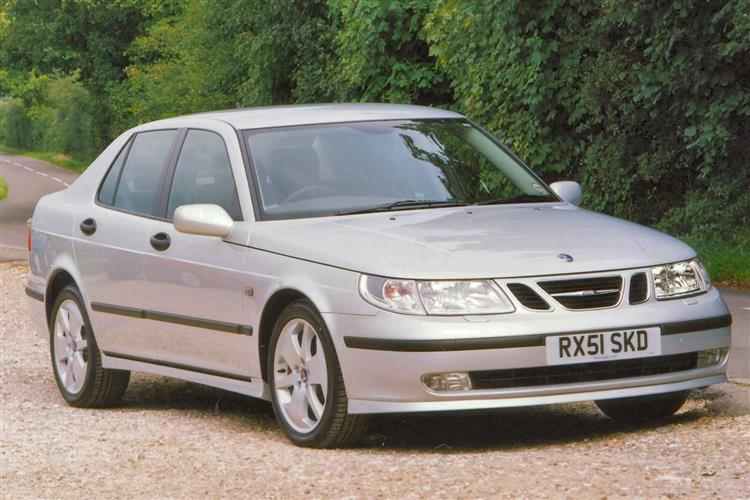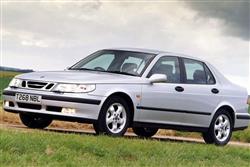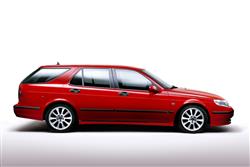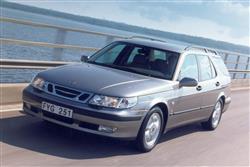MINT AERO (some text hidden) --NONE--
BY ANDY ENRIGHT
Introductionword count: 105
Saab likes to play up its aerospace associations. Whilst the Saab 9-5 hasn't been a soaraway success in terms of UK sales, it's business class credentials make it worth a look on the used market. Often denied a take off slot by rivals from Audi, BMW and Mercedes-Benz, the 9-5 is a stylish partner for the long haul traveller. With the 9-5, Saab gained clearance to enter the big league, and the car has quietly proved itself capable of taking on the establishment. Saab customers are a loyal bunch. Land a used 9-5 and you may be tempted to upgrade to their frequent flyer club.
Modelsword count: 24
Models Covered: 4 dr saloon & 5 dr estate [2.0t, 2.0t SE, 2.3t, 2.3t SE, 3.0 V6t, 3.0 V6t SE, 3.0V6t Griffin, Aero, Airflow]
Historyword count: 426
The 9-5's immediate predecessor, the 9000 series, was a bold attempt by Saab to share underpinnings with Lancia, Fiat and Alfa Romeo. Often seen today, this concept was maybe a little before its time when the range was launched in 1989. Since being enveloped by General Motors, Saab has been able to express its Swedish-ness whilst dipping into a vast pool of expertise. The 9-5 model rides on an extended version of Vauxhall's Vectra floorpan, but anybody expecting repmobile ambience will be pleasantly surprised by it. Introduced in June 1997, the 9-5 range initially consisted of the 2.0-litre and 2.3-litre cars, in either standard or SE specification. The 2.0-litre models were powered by an 'Ecopower' light pressure turbocharged four cylinder engine that developed 150bhp. The 2.3-litre cars used similar turbocharger technology in order to provide smooth power delivery, and these four cylinder engines produced 170bhp. All of the 2.0 and 2.3-litre cars were four-door cars, available with either a five-speed manual gearbox or a four-speed automatic option. The 3.0-litre cars were introduced in February 1998 and boasted a 200bhp engine. These were available only with the four-speed automatic box. In July 1998 a mechanically identical luxury version of the V6 was launched, christened the Griffin. October 1998 saw the range supplemented by handsome five door estate versions. In 1999 a more sporting option was launched, the Aero. This was a 2.3-litre car fitted with an aggressive bodykit, and suspension modifications designed to handle all 230bhp the 'HOT' designated engine now developed. Saab had turned back the clock to old-school 'big bang' turbocharging with some panache. The mean look was well received and the Saab 9-5 'Airflow' range of cars was introduced in January 2000, giving the four cylinder cars a more sporting appearance. These cars lasted until that Autumn when Saab introduced a series of range upgrades and added a more powerful 185bhp 2.3-litre petrol engine to sit above the existing 150bhp 2.0-litre unit. The range received a facelift in summer 2001, with a different grille, bigger bumpers and some interior tweaks. The Aero's engine was boosted to 250bhp and a 3.0-litre diesel model, the TiD, was announced alongside a 2.2-litre diesel unit purloined from the 9-3 range. The 3.0-litre V6 petrol engine was ditched in autumn 2003 to make way for a more powerful, more economical, less expensive and less dirty 2.3T powerplant boasting a hefty 220bhp wallop. A further hefty facelift in the later stages of 2005 brought a sleeker look to the 9-5 front end. There were even bioethanol fuelled versions to consider.
What You Getword count: 233
Sit in a 9-5 and it is still very much a Saab. Fears that the essentially quirky character of the Swedish manufacturer would be ironed out by General Motors have, thankfully, not materialised. You are still faced with a sheer wall of dashboard, the ignition key still slots home just ahead of the handbrake, and the bonnet is still of the original 'clam shell' style. The 'interesting' styling of Saab's not so distant past has mellowed, and the 9-5's is a far cry from the quirky 9000 shape. Aiming to highlight the relative expense of rival offerings, Saabs have generous standard equipment. Ski flaps, heated mirrors and outside temperature gauges on all models perhaps betray the 9-5s Scandinavian origins, but that's part of the charm. The provision of wood veneer trimmed interiors and leather steering wheels reaches down to SE designated models at prices which make rival Audis and BMWs look away in embarrassment. The Griffin models have had the whole options list thrown at them, and the results are impressive. These features include metallic paint, multi function computer, leather upholstery with ventilated front seats and a 200-watt, nine-speaker stereo system. The estate variants, whilst not rivalling the Volvo range for sheer capacity, are nonetheless worthy additions to the range. Interior space in all 9-5 models is significantly good, and there's a logic, albeit a Scandinavian logic, to the layout of the controls.
To see the full road test text contact us on 0330 0020 227
Pictures (high res disabled)


|

|

|
Scoring (subset of scores)
Category: Luxury Saloons and Estates
| Performance | |
| Handling | |
| Comfort | |
| Space | |
| Styling, Build, Value, Equipment, Depreciation, Handling, Insurance and Total scores are available with our full data feed. | |



